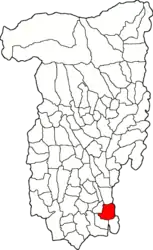Drăgășani
Drăgășani (Romanian pronunciation: [drəɡəˈʃanʲ] (![]() listen), archaic English: Dragashan) is a city in Vâlcea County, Romania, near the right bank of the Olt river, and on the railway between Caracal and Râmnicu Vâlcea. The city is well known for the vineyards on the neighboring hills that produce some of the best Wallachian wines.[3]
listen), archaic English: Dragashan) is a city in Vâlcea County, Romania, near the right bank of the Olt river, and on the railway between Caracal and Râmnicu Vâlcea. The city is well known for the vineyards on the neighboring hills that produce some of the best Wallachian wines.[3]
Drăgășani | |
|---|---|
 | |
 Coat of arms | |
 Location in Vâlcea County | |
 Drăgășani Location in Romania | |
| Coordinates: 44°39′40″N 24°15′38″E | |
| Country | |
| County | Vâlcea |
| Government | |
| • Mayor | Cristian Nedelcu[1] (PSD) |
| Area | 44.57 km2 (17.21 sq mi) |
| Population (2011)[2] | 17,871 |
| • Density | 400/km2 (1,000/sq mi) |
| Time zone | EET/EEST (UTC+2/+3) |
| Vehicle reg. | VL |
| Website | www |
The city administers four villages: Capu Dealului, Valea Caselor, Zărneni and Zlătărei. It is situated in the historical region of Oltenia.
History
| Year | Pop. | ±% |
|---|---|---|
| 1900 | 4,398 | — |
| 1912 | 6,710 | +52.6% |
| 1930 | 7,002 | +4.4% |
| 1948 | 9,737 | +39.1% |
| 1956 | 9,963 | +2.3% |
| 1966 | 11,589 | +16.3% |
| 1977 | 15,647 | +35.0% |
| 1992 | 22,126 | +41.4% |
| 2002 | 22,499 | +1.7% |
| 2011 | 16,681 | −25.9% |
| Source: Census data | ||
Drăgășani stands on the site of the Daco-Roman Rusidava. On 19 June 1821, during the Greek War of Independence, the Ottomans routed the Filiki Eteria troops of Alexander Ypsilantis near the city in the Battle of Dragashani.[3] There Tudor Vladimirescu fought with his Panduri, revolutionary fighters consisting mainly of peasants and not armed with firepower, against the Turks.
Notes
| Wikimedia Commons has media related to Drăgășani. |
- "Results of the 2016 local elections". Central Electoral Bureau. Retrieved 3 April 2020.
- "Populaţia stabilă pe judeţe, municipii, oraşe şi localităti componenete la RPL_2011" (in Romanian). National Institute of Statistics. Retrieved 4 February 2014.
- Chisholm, Hugh, ed. (1911). . Encyclopædia Britannica. 8 (11th ed.). Cambridge University Press. p. 465.
